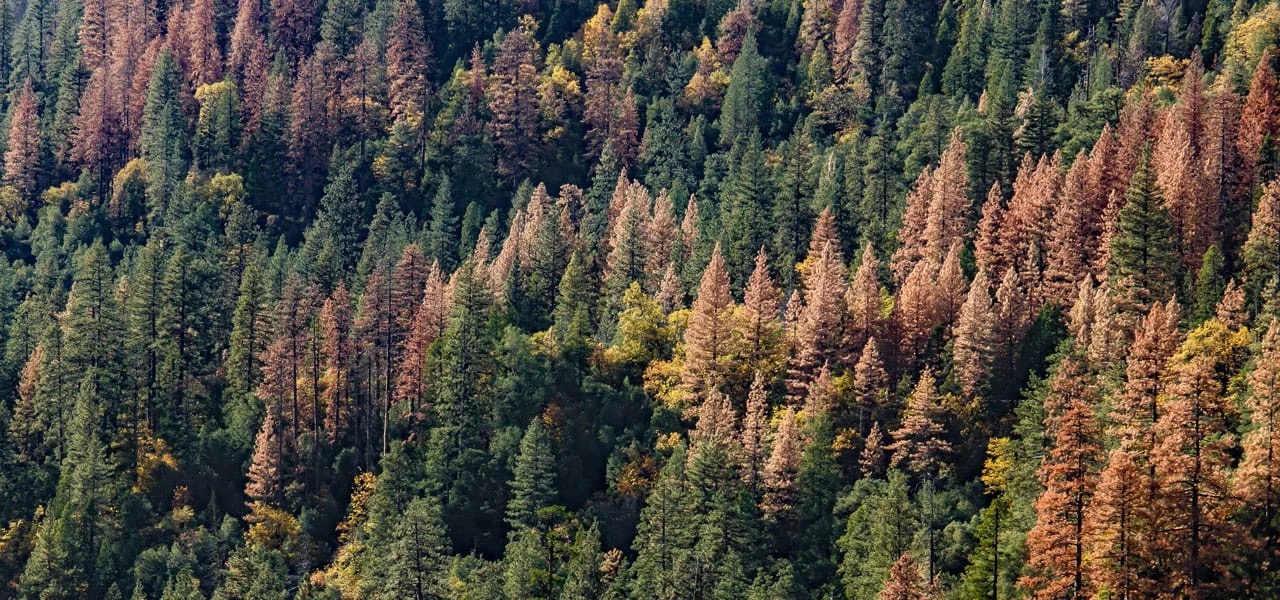Wind rustling through aspen tree leaves may be one of the most soothing sounds in the world, but have you ever thought about the relationship between trees and wind?
Storms with strong winds can cause trees to break or fall, so that may be what comes to mind, but there are also ways that trees and wind work together.
In this article, we’ll look closer at the relationship between wind and trees, both the positive aspects and the negative. We’ll also discuss things to watch for after windstorms and how you can help your trees grow strong. Keep reading to learn more!
Fun Fact: A Wind and Tree Conference is held annually to discuss the impact of wind on trees, specifically trees found in forests worldwide.

Wind Helps Trees Grow Stronger
When scientists created Biosphere 2 to study if the earth’s plants could be grown elsewhere, they discovered the importance of wind as trees grow.
Without wind, trees are weaker and die much more quickly. Wind causes a tree to move as it grows, which signals the tree to create reaction wood. This reaction wood helps the tree as it grows and prevents the tree from collapsing from its own weight. In short, wind causes stress to growing trees, but they become stronger as a result.
This is the same reason we recommend not staking young trees for very long – they need to move with the wind in order to grow that reaction wood.

Pollen haze in Evergreen, CO, and a close-up photo of a wind-pollinated conifer tree.
Wind Pollenates Some Trees and Plants
While trees and plants with flowers rely on pollinators such as bees or butterflies to spread their pollen, many trees, grasses, and plants are wind pollinated. Most conifers and grasses grown in Colorado rely on wind pollination.
Pollen in the air becomes very evident to those that suffer from pollen-related allergies. Here in the Front Range of Colorado, there are times when you can see the fog-like pollen in the air, causing a yellow-shaded haze to cover the area.
Ponderosa pines create much of this “yellow scourge” in our area, usually around June of each year.
While pollen in the air can be inconvenient to humans, wind pollination is how many trees and plants ensure their species’ survival.
Learn more about tree pollination from the Colorado State Extension >>

Some Trees Block the Wind
Trees can also work to protect buildings, farmland, or other plants from the wind. Creating a row or hedge of trees or shrubs to protect from the wind is often called a “windbreak.”
Windbreaks can protect from drying winds, lower the heating bills for your home, and often function as a snow fence, diverting drifting snow from high-traffic areas.
Trees that work well for a windbreak include:
- Eastern redcedar
- Rocky Mountain juniper
- Austrian pine
Learn more about how to plan and plant a windbreak >>

Some Trees Need Protection From the Wind
Some types of trees, by contrast, suffer from too much exposure to harsh winds. A good example of this in Colorado is the Linden tree. Linden trees work well as landscape trees but can suffer from our dry summer winds, leading to aphid damage.
By contrast, some trees are considered wind resistant. These trees are most often native to the area and need plenty of room for their roots to spread out (this keeps them well-anchored in strong winds). Many drought-tolerant trees are also wind-resistant.

LAM Tree provides winter watering services to young trees on a Colorado Front Range property.
Wind Can Dry Out Trees
Both summer and winter winds in Colorado can have a drying effect on our trees, which is why we emphasize watering your trees, including winter watering.
Winds dry out tree leaves more quickly, so it is vital to ensure the tree roots have access to enough water to replenish the moisture in the tree. Trees move water to the leaves for the process of photosynthesis. However, winds will blow away any water near the leaf surface, causing the tree to bring more water to the leaves through the roots. When no water is available, the leaves will dry out, turn brown, and/or curl.
Young trees (planted or transplanted in the last 3-5 years) especially need more water to survive in windy conditions.
Learn more about watering your trees >>

Wind Can Leave Unseen Damage
When strong winds or storms blow through, much of the tree damage is immediately apparent: toppled trees, broken limbs, and fallen branches are noticed and (hopefully) dealt with swiftly.
However, much of the damage caused by winds may not be immediately noticed. Branches that have broken but are high up in a tree’s canopy won’t be spotted until they eventually fall. Branches with large cracks that haven’t fallen will ultimately die, becoming a hazard.
Most importantly, some trees may have sustained damage that will lead to the eventual failure of the tree. These trees can be hazardous to buildings, property, and people, as there’s no knowing when they may break, fall, or otherwise cause damage.
That’s why it’s so important to check over your trees after any strong winds and schedule a professional tree care consultation for the trees you can’t view or safely reach.
Schedule a tree care consultation with LAM Tree Service >>

Worried About the Wind? LAM Tree Service Can Help!
From tree planning and planting to watering and tree inspections, the professionals at LAM Tree Service can help with your wind-related tree needs.
We know the best trees suited for our area, which would work best as a windbreak on your property, and which may need some extra protection.
We also know how to check for any wind-related damage to your trees.
Contact LAM Tree Service with questions about trees, wind, and your Colorado Front Range property.



